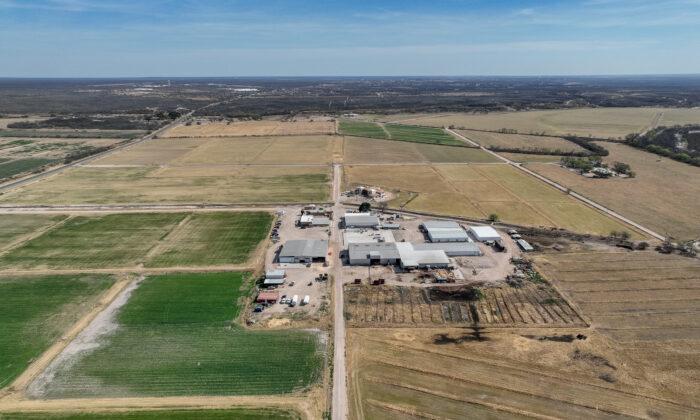Texas has seen the greatest increase in foreign-owned agricultural land and also leads the nation in agricultural land owned by foreign entities, according to a recent report from the U.S. Department of Agriculture.
Failed Legislation
Earlier this year, Texas Sen. Lois Kolkhorst authored legislation that would ban citizens, governments, and other entities of adversarial countries from purchasing farmland and homes in the state of Texas.The earlier legislation, filed in 2021, was in response to the purchase of about 140,000 acres near Laughlin Air Force in Del Rio, Texas, by billionaire Guangxin Sun, a Chinese investor with deep ties to the Chinese Communist Party (CCP).
Mr. Sun’s plans to build a wind farm set off alarms in the Texas legislature. They feared the CCP-linked investor would provide Beijing with access to the state’s electrical grid.
The measure was unanimously passed in the legislature and signed into law.
Ms. Kolkhorst’s recent proposed legislation, SB 147, received pushback from some Democratic lawmakers, such as state Rep. Gene Wu, who argued the bill was unfair to those who immigrate to the United States from hostile countries.
In late April, a watered-down version of the bill was approved in the Senate. The revised bill removed the restrictions for permanent residents and dual citizens to purchase property in the state.
“This bill protects Texas farmland, oil and gas, rare earth materials, and timber from being owned by foreign entities classified as hostile by the director of U.S. National Intelligence for three consecutive reports,” Ms. Kolkhorst wrote. “These nations currently include China, Russia, North Korea, and Iran.”
“A bill is filed in the Texas legislature to ban citizens, governments, [and] entities of China, Iran, North Korea, [and] Russia from purchasing land in Texas,” Mr. Abbott wrote.
However, the legislation never made it to the governor’s desk.
“We had a good bill, but it died in the house,” Texas Department of Agriculture Commissioner Sid Miller told The Epoch Times.
Russell Boening, president of the Texas Farm Bureau, told The Epoch Times that he understands the concern that many people have regarding foreign investments in state agricultural land, but he is not sure it should be completely banned.
Which Countries Own the Most Texas Ag Land?
Surprisingly, the country that holds the greatest investment in Texas agricultural land is Canada, with over 1.6 million acres in 2021. The figure shows a decrease of about 66,000 acres from 2020.Mr. Miller explained that the Canadian figure is “misleading” since it is reflective of a Canadian investment fund in East Texas forest land, which produces timber. The land is not owned by foreign individuals, he explained.
The Netherlands ranks second with 392,101 acres of Texas ag land, followed by Germany with 332,679, Italy with 216,749, and the United Kingdom with 173,774 acres. China ranked 18th in agricultural land ownership in Texas at the end of 2021, according to the 272-page report.
Agricultural land is made up of three main categories: forest land, pasture land, and cropland.
National Issue
The issue of whether or not to restrict foreign ownership of the nation’s agricultural land has been a hotly debated topic in Congress.“Food security is national security,” said Sen. Kevin Cramer (R-N.D.) in a statement earlier this year. “Our government must be diligent in conducting risk assessments of agriculture investments by foreign adversaries—for reasons including geopolitical strategy, U.S. Supply chain protection, and support of American farmers and ranchers.”
The proposal would add the U.S. Secretary of Agriculture as a member of the Committee on Foreign Investment in the United States. It would also require the USDA and Government Accountability Office (GAO) to provide reporting on current and potential foreign investments.
“Our adversaries are working overtime to undermine American interests, and the FARM Act will be an important step to secure America’s food supply by identifying and responding to inappropriate interference,” he continued.
Currently, the USDA requires foreign investors to file a form detailing their purchase with the Farm Service Agency in the county where they acquired the land. The form also requires the buyer to disclose the intended use of the land.
“We have a federal law that says if you’re a foreign entity or person and you’re going to invest in land in the United States, you have to report it on a form,” Mr. Miller said. “But it’s just a reporting requirement, and it hasn’t been enforced.”
“Our goal is not to penalize then It’s to get the information,” a USDA official told Agri-Pulse. “We don’t have an investigatory arm. We’re not going out and trying to seek out people who may or may not be reporting.”
Other Notable Increases in Foreign Ownership
In addition to Texas, Arkansas and North Carolina have also seen large increases in foreign-owned acres in 2021, coming in second and third in the nation with nearly 250,000 acres and nearly 247,000 acres, respectively.As far as the greatest number of acres held by foreign entities, Maine ranked second behind Texas with over 3.6 million acres, followed by Colorado with 1.9 million acres.
Overall, Texas, Arkansas, and North Carolina account for 43 percent of the increase in foreign-owned agricultural land.
Only three states, Hawaii, Iowa, and Utah, showed a decrease in foreign-held ag lands, with an overall reduction of more than 52,000 acres. The decrease “reflects long-term leaseholds which were terminated and the sale of various types of agricultural land,” the AFIDA report noted, adding that some of the changes are reflective of previous transactions and late filings.
The state with the highest percentage of foreign-owned agricultural land is Maine, at roughly 20.1 percent. Hawaii is second with about 9.2 percent.
“The majority of foreign-held agricultural land in Maine consists of forest land while the bulk of Hawaii’s foreign-held land is pasture land,” according to the report.
Between 2015 and 2021, foreign holdings of U.S. agricultural land increased by an average of about 2.2 million acres per year, up from an average of 0.8 acres per year between 2011 and 2015, according to the report.
“The most significant acreage increases between 2011 and 2021 were in forest land, cropland, and pasture,” the report stated. “During this time, forest land increased from roughly 13.8 million acres to 19.2 million acres, cropland increased from roughly 4.9 million to 11.8 million acres, and pasture land increased from approximately 6.0 million acres to nearly 7.3 million acres.
“The changes in pasture land and cropland are mostly due to foreign-owned wind companies signing, as well as terminating, long-term leases on a large number of aces; however, the acres used by said companies are few due to the small footprint of the wind towers erected on the land.”







